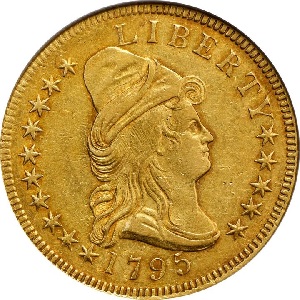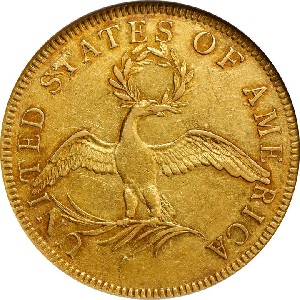1795 Capped Bust Small Eagle $10 Eagle, 9 Leaves
A group of 100 of the first $10 gold eagle pieces struck by the United States was presented to President George Washington by Mint Director Henry De Saussure in October 1795. At that time, Philadelphia was the nation’s capital, so De Saussure didn’t have far to travel from the Mint facility to the presidential office.(1)
The coin type presented to Washington is often called the Capped Bust eagle, but other descriptions are also used.
For the first three years of its existence (1795-97), the Capped Bust eagle reverse featured a smallish eagle with extended wings, perched on an olive branch while holding a wreath high in its beak. In 1797, the small eagle reverse was replaced by a larger, “heraldic” eagle, which continued until 1804.(2)
When De Saussure replaced the retiring David Rittenhouse in July 1795, his prime focus was to quickly initiate gold coin production. The five dollar half eagle was the first to see action, with 744 pieces delivered on July 31, 1795. The ten dollar eagle’s turn came in September, when 1,097 pieces were struck.(3)
Production of the 1795 eagle continued throughout the year. Mint records show 2,795 were delivered during the calendar year. Because 1795 obverse dies were still in working condition, they remained in service in the early months of 1796, as a cost-saving measure. Most experts believe there were 2,788 pieces struck in the first three months of 1796 from 1795-dated dies, bringing the estimated mintage for the 1795 eagle to 5,583 pieces.(4)
There are two major varieties of the 1795 Capped Bust $10 small eagle reverse. One variety has an olive branch with 13 leaves. On other variety, the branch has only nine leaves. Of these two, the “9 Leaves” reverse is by far the rarest.
Five die varieties (a.k.a. die marriages) were employed in the coining of the 1795 eagle. Four of them had the 13 leaves reverse. A single pair of dies, referenced as the Bass-Dannreuther-3 die variety (BD-3 for short) was used to strike the “9 Leaves” issue. Researcher John Dannreuther estimates a range of 210-500 examples of the BD-3 were struck.
The scarcity of the “9 Leaves” variety occurred because the BD-3 marriage ended after a swift “divorce.” That is, the reverse die failed early in the production run and had to be removed from service.(5)
No one is sure why some of the 1795 eagles were given only nine leaves. Some scholars speculate the Mint was experimenting to get the most aesthetic appearance (first nine leaves, then 13, finally settling for 11 in 1796). Others surmise the die sinker simply got careless and lost track of how many leaves were punched. This is yet another unsolved mystery from the early Mint.
The 1795 Capped Bust eagle has been a “Want List” darling with collectors since at least the mid-19th century, but there was little interest in gold coin die varieties until much later. The nine leaves discovery is credited to William H. Woodin, who in 1926 identified it. Edgar Adams was the first to fully describe the variety in the May 1934 edition of The Coin Collector's Journal.(6)(7)
A second example did not emerge until 1960. As collector awareness mounted, more specimens slowly came to light.(8) Currently, we know of about 22 survivors of this famous coin.(9)
President Washington closely monitored the activities leading up to the striking of the 1795 $10 eagle, the flagship gold coin of the newly formed republic, recognizing its importance in establishing the United States as a presence among the world’s sovereign nations.(10) Foresighted collectors of today see the same thing Washington did.
| Estimated survivors in all grades: 22 ?
The survivor estimate from PCGS represents an average of one or more experts' opinions as to how many examples survive of a particular coin in all grades. Survival estimates include coins that are raw, certified by PCGS, and certified by other grading services. Learn more at PCGS. |
| PCGS Rarity Scale: 9.0 ?
The 'PCGS CoinFacts Rarity Scale' assesses the relative rarity of all U.S. coins, based on estimated surviving examples. The scale runs from 1.0 to 10.0. The higher the number, the rarer the coin.
Learn more at PCGS. |
| Click HERE to check for availability on eBay** |
Preview of eBay selection (if no 1795 9 Leaves in Preview, hit HERE link above):
 |
 |
| Trendline Avg = 5.49 | CLASSIC RARITY |
Historic Value Trend Charts:
| Last updated 9-6-24 | Return to Key Date Coin List | |
| There are no Common Date comparisons for this coin. | ||
|
|
||
| Download Charts to Your Computer | ||
Sources
1. Garrett, Jeff and Guth, Ron. 100 Greatest U.S. Coins, 5th ed. Pelham, AL: Whitman Publishing, 2019.
2. Yeoman, R.S. and Garrett, Jeff, et al. A Guide Book of United States Coins, 75th ed. Pelham, AL: Whitman Publishing, 2021.
3. Heritage Auctions. 1795 $10 13 Leaves BD-5. Aug 2014 Auction.
4. Heritage Auctions. 1795 $10 9 Leaves, BD-3. Jan 2023 Auction.
5. Stack's Bowers Galleries. 1795 Capped Bust Eagle BD-3, 9 Leaves. Aug 2021 Auction.
6. Stack's Bowers Galleries. 1795 Capped Bust Eagle BD-3, 9 Leaves. Aug 2019 Auction.
7. Heritage Auctions. 1795 $10 9 Leaves, BD-3. Jan 2022 Auction.
8. Stack's Bowers Galleries. 1795 Capped Bust Eagle BD-3, 9 Leaves. Aug 2019 Auction.
9. PCGS. 1795 $10 9 Leaves (Regular Strike).
10. Orosz, Joel J. and Augsburger, Leonard D. The Secret History of the First U.S. Mint. Atlanta, GA: Whitman Publishing, 2011.
**Many very fine coin dealers sell on eBay. At any point in time, there may be over one million search results for United States coins. This includes quite a few of the recommendations on our Key Date Coin List.
If you’re thinking about purchasing a rare coin, eBay is certainly worth a look. For your convenience, the links from this site to eBay are coded to bring up only coins certified by PCGS and NGC.
As is always, always the case, never buy a valuable coin from a seller whose trustworthiness cannot be verified. Learn more about this at our chapter Best Places to Buy Coins, which also has a section on doing business on eBay.
In the interest of full disclosure, Rare Coins 101 receives a small commission anytime someone connects to eBay from this site and purchases something.
Coin images by Stack's Bowers Galleries.


